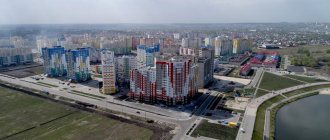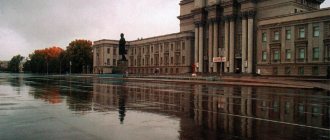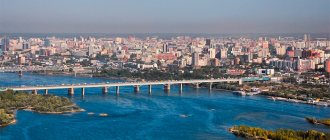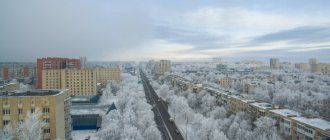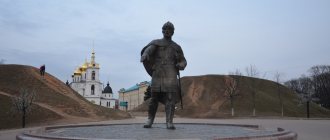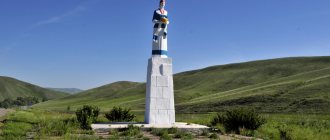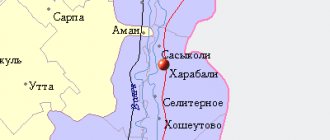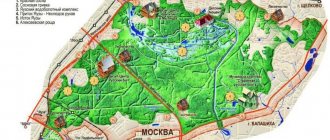Part 2. Architectural.
In addition to the “Embankment of Bruges”, Yoshkar-Ola still has something to boast about. Take, for example, the cultural and historical complex “Tsarevokokshay Kremlin”, built in 2009 according to all the canons of a fortification structure of the 14th-15th centuries, the only thing missing is embankments and a deep ditch:
(The photo is not mine, it was found on the Internet, I just didn’t have a good quality photo in my reserves)
On the territory of the Kremlin (by the way, the youngest in Russia) there is an exhibition of artillery pieces, as well as stands with the history of the Mari land and a small chapel.
In addition to the Kremlin, there are unique fortress walls on the right bank of the Kokshaga River, behind them are “hidden”: the recently built Cathedral of the Resurrection of Christ, several government buildings and residential buildings, all of this together creates a beautiful picture, not inferior in beauty to the Bruges embankment located opposite:
The same thing, but a little closer and from a different angle:
On Patriarchal Square, which is located on the left bank of the river, in addition to the monuments to Alexy II and Peter and Fevronia, which I already talked about above, you can see two unusual buildings: this is the “12 Apostles” complex, similar to a fairy-tale palace, which includes a restaurant, supermarket and television and radio company:
The photo is not mine either. The same problem: there is no high-quality photograph of this building, taken from this site
and the Republican Puppet Theater, stylized as a medieval castle, not yet completed:
The “12 Apostles” complex, in addition to its appearance, is also interesting because of the performance that takes place every three hours, repeating the well-known gospel story - the Entry of the Lord into Jerusalem. To the accompaniment of music, 12 apostles led by Jesus appear from the tower, walk along the balcony and hide in another tower. A fascinating and exciting spectacle.
A similar mechanical system operates in another building - the Italian-style National Art Gallery, which is located on the square. Obolensky-Nogotkov, next to the monument to the governor:
Every hour, accompanied by church hymns, a plot is played out around the central clock telling about the salvation of the “Three-Handed” Icon of the Mother of God during the Turkish invasion of Serbia. An image of the Mother of God appears in the upper left corner of the clock, then a donkey with her image appears from the lower left gate, symbolizing the miraculous salvation of the icon and the coming of the Mother of God. The donkey enters the right gate, it closes, after which the blessing image of the Queen of Heaven appears above it again.
Another attraction of Yoshkar-Ola is the Annunciation Tower, which is a smaller copy of one of the towers of the country’s main Kremlin. The chimes, like the original, chime every hour.
In the next photo, in front of the tower you can see one of the largest fountains in the city - the Archangel Gabriel fountain, trimmed with green malachite stone:
Next to the Annunciation Tower is the Arkhangelskaya Sloboda - a small pedestrian area built up with Italian-style mansions, in which there are service offices for a number of banks and government services.
At Arkhangelskaya Sloboda, I will finish the story about the main attractions of Yoshkar-Ola, however, once in this city, you can discover many interesting and beautiful places that are not described in this review. Be sure to visit the newly built Cathedral of the Annunciation of the Blessed Virgin Mary, stroll along Assumption Street and the flower-filled Chavaina Boulevard, sit in the quiet and cozy park of the government building.
Yoshkar-Ola – an amazing fake city (38 photos)
This year I finally managed to find myself in Yoshkar-Ola, a very strange city about which I heard quite contradictory reviews, from enthusiastic “This is the real Europe!” to curses and accusations of crimes against architecture. In general, while almost all of real Europe remains closed for quarantine, I decided to see what the capital of the Republic of Mari El is like.
My way to Yoshkar-Ola from Tula passed through Nizhny Novgorod, where I decided to stop by and see what had changed since my last visit, but it turned out that the city was preparing to celebrate its anniversary, so all the main attractions were closed for renovations. As a result, I lost some time there, got wet in the rain and reached my final destination at dusk.
I can say that in the evening I liked the city; the night illumination and the mirror surface of Malaya Kokshaga created quite postcard views of the city.
In the morning, all the evening romance has dissipated along with the darkness, and some kind of ridiculous copy appears before us, as if hastily forged in cheap Chinese workshops.
If anyone doesn’t know, the former head of the republic, and now the current prisoner for bribes and abuse of power, for some reason decided to turn Yoshkar-Ola into a parody city. Perhaps he was preparing in advance for a pandemic and the closure of borders, so for several years he built up the city, first with copies of Russian landmarks, and then European ones. I think that by the order of appearance of new buildings one can track in what year he went to Crimea, and when he already visited Venice.
We will start with the visiting card of the city - the Republic Square and the Blessed Virgin Mary.
Here we are immediately struck by a copy of the Spasskaya Tower of the Moscow Kremlin, with its own chimes striking every hour.
At the same time, when you look at it, you immediately understand that this is a new building and something is wrong with it. It always amazes me how in the 21st century it is possible to build inharmonious buildings with strange proportions, that it is inferior to the buildings of the 17th century, although logic dictates that over time general skill and skill should only progress. But you can immediately see when the building was designed by an architect, and when it was built by migrant workers from photographs and memories from the vacation of the head of the region.
It’s funny that on the same line with the “Spasskaya Tower”, on the other side of the Malaya Kokshaga River, there is another fake tower, which, apparently for confusion, was called Spasskaya, although it is a copy of the Borovitskaya Tower of the Moscow Kremlin.
Perhaps the least number of questions is raised by the building of the Annunciation Cathedral, in which, although the features of St. Basil's Cathedral and the Church of the Savior on Spilled Blood are discernible, it does not look like a cheap parody.
And now a riddle, can you guess without a hint what the building on the left is a copy of?
Of course, this is an exact copy of the famous Crimean castle “Swallow’s Nest”, just look at how accurately the builders managed to convey the Gothic features and its beauty, even it is not immediately clear that this is not the original (hint, the original is below, do not confuse it).
Source: ru.wikipedia.org
One of the things that is completely incomprehensible to me, which applies not only to Republic Square, is how the city misuses urban space. So you made landmarks, set up beautiful pseudo-European houses between them. It seems that this should become a place of attraction and relaxation for tourists and residents, but instead of opening a cafe here and setting up tables, most of the buildings house various offices of insurance companies and banks. As a result, we get a huge deserted space in the city center.
A similar situation concerns local embankments, so you decided that you will have your own Europe, you built houses that even look good from the opposite bank, and look great at night.
But some tourist arrives from, so to speak, Tula, walks along the entire Bruges embankment and doesn’t come across a cafe where you can sit and eat a Belgian waffle or drink Guinness (of course, I was completely daydreaming), but there simply isn’t any not a single bench to just sit on.
At the same time, quite a lot of benches were placed on the territory of the Tsarevokokshai Kremlin, which is also a new building and more of an empty concrete square surrounded by a three-meter brick fence. That is, someone seriously decided that in the summer it would be more pleasant for people to sit in a stone box without a single tree than on an embankment near the water.
We move to Patriarchal Square, where, as the name suggests, there is a monument to Patriarch Alexy II.
But we came here not for him, but for the sake of two very different buildings that I noticed the night before.
The first of them (on the left) is distinguished by the tower with the “12 Apostles” clock, which, as they write everywhere, is “the first and only project of a clock with a movable sculptural composition on the territory of the entire Russian Federation.” To briefly describe the essence, every three hours, accompanied by the ringing of bells and church hymns, a figure of Christ on a donkey leaves one door, accompanied by the apostles, who move rather slowly along the facade to another door (a fragment is in the video above).
By the way, the building is a wonderful copy of the Sheremetyev castle in the village of Yurino:
Source: ru.wikipedia.org
Second, this is my favorite copy that I met in Yoshkar-Ola. By a large margin from all competitors, the building of the Republican Puppet Theater came to the top of my personal top list.
At first glance, it seems that this is a copy of some castle from a Disney fairy tale, or an analogue of a building from one of their amusement parks, but take a closer look at these neo-Romanesque features.
Before us is a copy of the famous Bavarian castle of King Ludwig II - Neuschwanstein. Isn't this just amazing?
Source: ru.wikipedia.org
Finally, it is worth mentioning separately not only the architectural madness that is happening in Yoshkar-Ola, but also the strange choice of objects for the installation of monuments. If there are no questions about the monuments to Gogol or Pushkin and Onegin, then questions arise in other places.
It remains a big mystery why a monument to Lorenzo Medici or Rembrandt was erected in the capital of the Republic of Mari El, and a monument to Prince Rainier III of Monaco and American actress Grace Kelly was erected in front of the local registry office as a symbol of love and fidelity.
Well, what I wanted to say in the end, I’m ready to put up with all the parody of local attractions, which are better viewed at night or from the opposite bank, if it was all done for people, but here it’s clear that the only person for whom this is all done - now he is in prison. It is not clear why this particular path was chosen to transform the city; it seems to me that for the same money they could have hired normal designers and made an original and convenient embankment that would have become a place of attraction for people.
Well, now some interesting facts about the capital of the Republic of Mari El:
- Fans of the Tula Arsenal should know that the team's goalkeeper and playing coach Alexander Filimonov was born in Yoshkar-Ola and began his football career in the local Spartak (I wonder if a monument dedicated to the famous football player will ever appear in the city and if so, what it will look like ).
- In Yoshkar-Ola, as throughout the republic, bilingualism is in use; in addition to Russian, the Mari language is used to write words, using the Cyrillic alphabet, supplemented by several specific sounds. Therefore, some signs look amazing - seemingly familiar and familiar letters form incomprehensible words, for example: Yolchiem - shoes. Yapok kachkysh - Japanese cuisine. Kevyt – shop. Urem - Street. Bus station - bus station
- Part of the population of the republic has not yet converted to Christianity, and professes a traditional religion; in general, the Mari, especially in the villages, are a very superstitious people, among whom sorcerers and shamans have a truly great influence (and this is in the 21st century)!
- The population of Yoshkar-Ola is about 258,000 people, approximately the same number live in Zarechye and Proletarsky district of Tula
- Prices in the city are at the same level as in Tula or even slightly lower.
- The best time to visit Yoshkar-Ola is July; it is not yet warm in June, and in August it is no longer warm. Winters are long and very snowy, with severe frosts.
By the way, would you like to share your “travel stories”? Write to [email protected] And long live our common endless and cheerful “Gulbari”!

Report to the project
My small homeland is the city of Yoshkar-Ola. This is the capital of the Republic of Mari El, a beautiful and modern city.
It is located on a flat area north of the Volga, in a zone of mixed and taiga forests. This is a beautiful and amazing region.
Yoshkar-Ola was founded in 1584 and now it is home to almost 300 thousand people.
City symbols
The symbols of the city are the flag and coat of arms. They depict a majestic elk, with golden horns and hooves, walking across a blue background.
The moose is a symbol of our forests.
